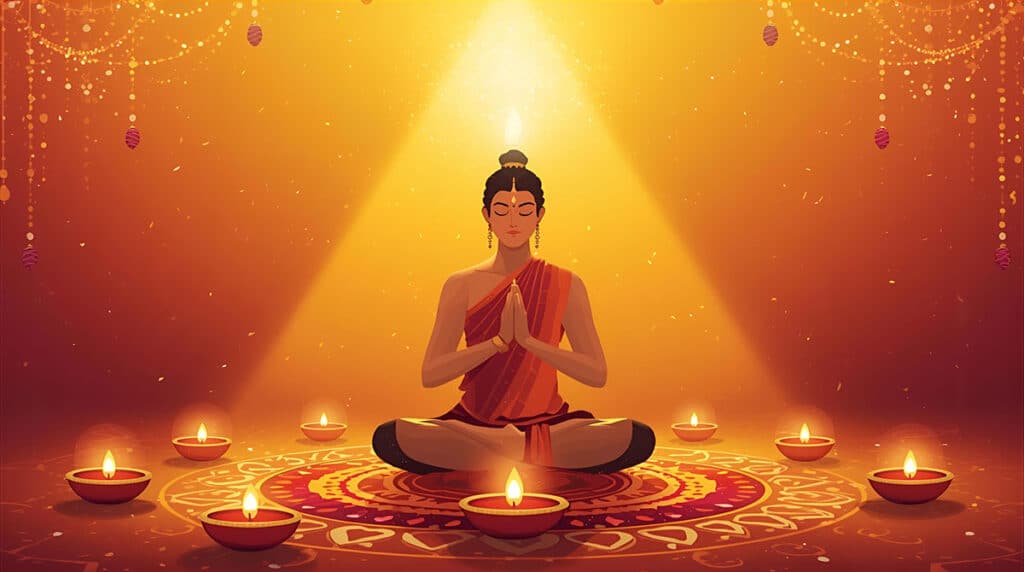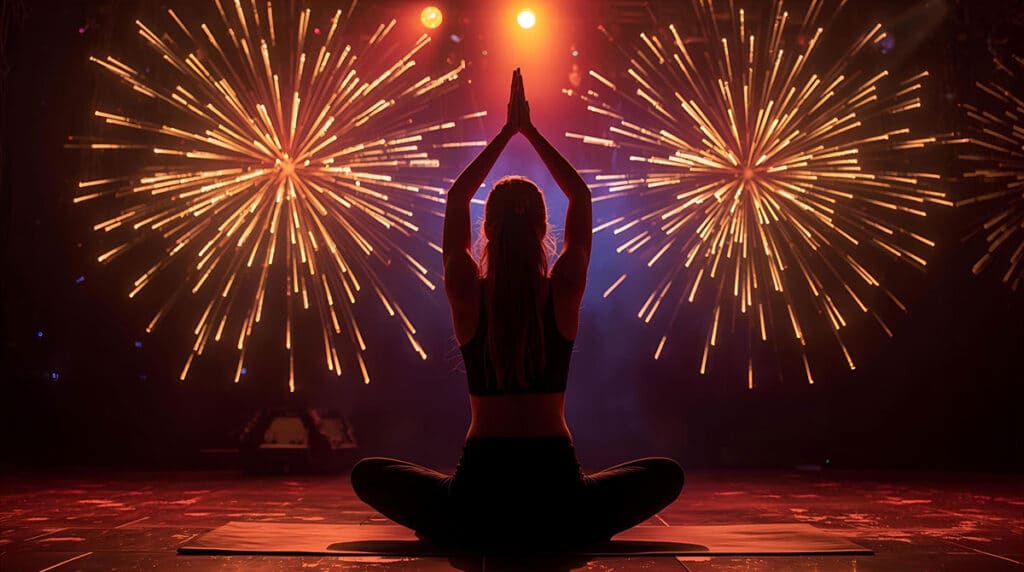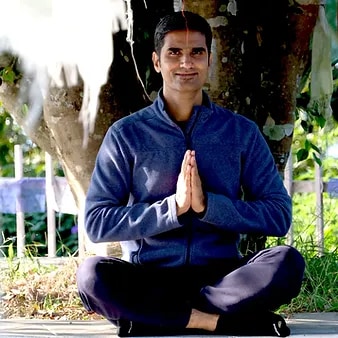Illuminating the Self: How Diwali Resonates with Yogic Wisdom
by Hardik Mehta

Every year, as homes glow with diyas and hearts fill with festive cheer, Diwali reminds us of deeper truths beyond the lights and sweets. It is a festival of light conquering darkness, of inner renewal and spiritual awakening. In many ways, Diwali and yoga walk hand in hand—both invite us to turn inwards, to cleanse, to uplift, and to transform.
In this blog, you’ll discover how weaving yoga into your Diwali observance can deepen your experience, boost your wellbeing, and reconnect you to the inner light. We’ll explore practical yoga tips, spiritual reflections, and how to align this ancient practice with the festival of lights.
Why “Diwali and Yoga” Make a Meaningful Pair
1. Symbolism of Light and Awareness
Diwali (also spelled Deepavali) literally means “a row of lights.” It is the time when we illuminate our surroundings, offer lamps, and dispel darkness. In yogic traditions, the flame or light is frequently a metaphor for awareness, clarity, and consciousness.
When we practice yoga—through asana, pranayama, meditation—the goal is to kindle that light within, to remove the veils of ignorance or inertia. Like Diwali’s inner symbolism, yoga encourages us to let the inner flame grow steady, bright, and unshaken.
2. Victory of Good Over Inner Obstacles
Diwali celebrates the triumph of virtue over vice, of hope and goodness over despair. In the yogic path, we continuously strive to overcome inner obstacles: negativity, inertia, fear, attachment. The festival reminds us that victory is possible—not by ignoring darkness, but by bringing light.
Thus, Diwali becomes an invitation: use your yoga practice as a sadhana to face inner shadows and emerge more awakened.
3. A Time for Purification & Renewal
Before Diwali, homes are cleaned, clutter is cleared, and new clothes and decorations appear. It’s a culturally established ritual of outward purification. Yoga complements that with inner purification—cleansing our minds, detoxifying our body, refining our intentions, and resetting our deeper rhythms.
4. Integration with Spiritual Intent
Many yogis treat Diwali not just as a cultural festival but as a spiritual milestone. It becomes a moment to recommit to one’s practice, to reflect on where one is headed, and to realign with a higher purpose.
Yoga Practices to Enrich Your Diwali
Below is a suggested roadmap. You can adapt based on your level and time. Even a few minutes can make a difference.
Morning: Surya Namaskar & Gentle Asana
Begin your Diwali morning with Sun Salutations (Surya Namaskar). This series of asanas connects you to the rising light, energises your system, and opens your body for the day ahead. Many yogic voices encourage this as a natural ritual on Diwali.
Then follow with simple asanas:
- Ardha Matsyendrasana (spinal twist) to encourage detoxification
- Trikonasana (triangle pose) to open the sides
- Balasana / Child Pose for grounding and rest
- Viparita Trikonasana (revolved triangle) for digestion and balance
These asanas support digestion, improve circulation, and help maintain steadiness amid festive bustle.
Midday / During the Festivities: Pranayama & Mindful Breaks
The celebrations can be physically and mentally overwhelming. Sneak in short pranayama breaks. A classic is Anuloma–Viloma (alternate nostril breathing)—a balancing, calming breath technique.
Even 3–5 minutes can reset your nervous system and bring clarity. Combine that with simple seated stretches or neck/shoulder rolls to relieve tension from standing, cooking, or greeting guests.
Evening: Candlelit Meditation or Yoga Nidra
As the evening deepens and the diyas glow, shift to a quieter, more inward practice. Try:
- Candlelit meditation: Sit comfortably, gaze softly at a flame, let the light draw your attention inward.
- Yoga Nidra (yogic sleep / guided relaxation) to release residual stress and let deeper rest occur. Many yogic blogs suggest Yoga Nidra as a restful ending to the Diwali day.
This can help you sleep deeply, integrate the day’s energies, and maintain balance even amid the late-night festivities.
Intentions & Sankalpa: Inner Resolutions
In traditional yoga, we often end or begin practices by reaffirming a sankalpa (sacred intention). During Diwali, set a sankalpa focused on light, peace, clarity, or service. This spiritual commitment gives your festival direction and purpose beyond the rituals.
Ethical Practice (Yama & Niyama)
Use the ethos of Diwali—generosity, compassion, harmony—to reflect on yoga’s moral limbs (yama and niyama). Offer help, speak kindly, forgive, give without expectations. This alignment between inner practice and outer action deepens your festival experience.
Tips to Maintain Yoga Amidst the Celebration
- Be kind to yourself: even 10 minutes is helping.
- Use mornings or late evenings when things are quieter.
- Combine movement with festive rituals (e.g. doing mild stretches while waiting for food or after puja).
- Prioritize rest—don’t skip Yoga Nidra or relaxation.
- Avoid extreme or very intense practice if you feel drained.
- Hydrate well, eat mindfully, and don’t lose your rhythm entirely.
As The Yoga Institute notes, festive yoga helps to calm the mind and reduce stress, and short, consistent practices are better than skipping altogether.
Benefits You’re Likely to Feel
- Enhanced mental clarity and focus
- Reduced stress and festive exhaustion
- Better digestion, vitality, hormonal balance
- A deeper sense of connection with inner life
- Spiritual uplift and renewed purpose
- A more harmonized festival experience—not just external, but internal too
Illuminating the Self While Celebrating the Festival: A Synchronized Journey

Diwali and yoga are not just coincidentally harmonious—they amplify each other. As you light diyas in your home, you light the subtle lamp within. As you clean and re-decorate, yoga encourages you to purify thoughts, detoxify the body, and realign your inner rhythm. As you celebrate with loved ones, yoga nurtures compassion, presence, and kindness in your interactions.
When approached intentionally, your Diwali becomes more than a social festival—it becomes an inner pilgrimage, a celebration of awakening. And yoga offers you the tools: asana, breath, meditation, ethics, presence.
Why This Matters—and How It Connects to Sayujya Yoga
You might be wondering: how is this relevant to Sayujya Yoga and why is this blog not just abstract theory but has practical value?
Sayujya Yoga is a Yoga Alliance–affiliated school run by couple Prutha Bhatt & Hardik Mehta, based out of Mumbai. They offer a wide range of yoga trainings, short courses, retreats, and online / offline classes.
The alignment is clear: this blog aims to bridge the festival of Diwali with the lived practices of yoga—and Sayujya Yoga offers precisely that: guided training, mentorship, structured curriculum, and community support to cultivate your yogic path.
Here’s how the relevance unfolds:
- If you’re celebrating Diwali and feeling inspired to deepen your practice, Sayujya Yoga is a channel to continue that journey.
- Their programs (200-hour yoga teacher training, short modules, retreats) solidify your habits beyond festive bursts of inspiration.
- They facilitate mentorship, structure, and a supportive environment—so your post-festival intentions are not lost in daily life.
- Because this blog encourages blending festival and yoga, Sayujya Yoga is a live example of how yogic community, training, and practice can sustain those insights.
Highlights of Sayujya Yoga’s Services
- 200-hour Yoga Teacher Training (offline & hybrid modes) — foundational training for those who wish to teach or deepen practice.
- Short courses / workshops in yoga, pranayama, meditation (for practitioners at various levels)
- Retreats & immersion experiences to amplify your yoga journey
- Online and in-person classes for sustained learning
- Community & support via mentor guidance, peer groups, resources
- Because they are Yoga Alliance affiliated, their alignment with global standards gives further credibility to those aspiring to teach or certify.
So, if this blog awakens in you the desire to go beyond one festival, to sustain your inner light, Sayujya Yoga may be your bridge—a place where intention meets structure, and insight meets practice.
Final Thoughts
This Diwali, let your celebrations embrace both external light and inner illumination. Let your yogic practice—no matter how small or modest—be a companion to the festival, not a casualty of its busyness. As you light diyas in your home, light the lamp within, clear away inner clutter, let your awareness shine, and emerge renewed, grateful, and radiant.
If you feel inspired to carry forward that light beyond Diwali, consider deepening your path with Sayujya Yoga. Their offerings may help turn a single festival of light into a lifetime of illumination.
About the Author

Hardik Mehta
Hardik is an E-RYT 500 & YACEP (Yoga Alliance Continuing Education Provider), Yoga Alliance, USA. He has been practicing yoga for the last 9 years. Prior to finding his true calling in Yoga, he was working with various corporates for 12 years in the Retail and eCommerce sector.
